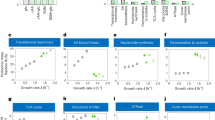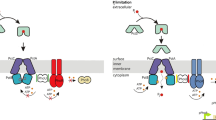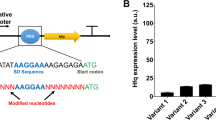Abstract
Metabolic flux distributions of recombinant Escherichia coli BL21 expressing human-like collagen were determined by means of a stoichiometric network and metabolic balancing. At the batch growth stage, the fluxes of the pentose phosphate pathway were higher than the fluxes of the fed-batch growth phase and the production stage. After the temperature was increased, there was a substantially elevated energy demand for synthesizing human-like collagen and heat-shock proteins, which resulted in changes in metabolic fluxes. The activities of the Embden-Meyerhof-Parnas pathway and the tricarboxylic acid cycle were significantly enhanced, leading to a reduction in the fluxes of the pentose phosphate pathway and other anabolic pathways. The temperature upshift also caused an increase in NADPH production by isocitrate dehydrogenase in the tricarboxylic acid cycle. The metabolic model predicted the involvement of a transhydrogenase that generates additional NADH from NADPH, thereby increasing ATP regeneration in the respiratory chain. These data indicated that the maintenance energy for cellular activity increased with the increase in biomass in fed-batch culture, and that cell growth and synthesis of human-like collagen could clearly represent the changes in metabolic fluxes. At the production stage, more NADPH was used to synthesize human-like collagen than for maintaining cellular activity, cell growth, and cell propagation.


Similar content being viewed by others
References
Daae EB, Ison AP (1999) Classification and sensitivity analysis of a proposed primary metabolic reaction network for Streptomyces lividans. Metabol Eng 1:153–165
Duan MR, Mi Y, Fan DD (2002) Kinetics of recombinant E. coli expressing human-like collagen fermentation. Chem React Eng Technol 18:238–243 (Chinese)
Fan DD, Luo YE, Mi Y et al (2005) Characteristics of fed-batch cultures of recombinant Escherichia coli containing human-like collagen cDNA at different specific growth rates. Biotechnol Lett 27:865–870
George HA, Powell AL, Dahlgren ME et al (1992) Physiological effects of TGF-PE40 expression in recombinant Escherichia coli JM109. Biotechnol Bioeng 40:437–445
Goel A, Ferrance J, Jeong J et al (1993) Analysis of metabolic fluxes in batch and continuous cultures of Bacillus subtilis. Biotechnol Bioeng 42:686–696
Gu QS, Jiang LX (2003) Collagen-based biomaterials in clinical medicine. The Second Military Medicine Press, Shanghai (Chinese)
Holms WH (1986) The central metabolic pathways of Escherichia coli: relationship between flux and control at a branch point, efficiency of conversion to biomass, and excretion of acetate. Curr Top Cell Regul 28:69–105
Holms H (1996) Flux analysis and control of the central metabolic pathway in Escherichia coli. FEMS Microbiol Rev 19:85–116
Hua XF, Fan DD, Luo YE et al (2006) Kinetics of high cell density fed-batch culture of recombinant Escherichia coli producing human-like collagen. Chin J Chem Eng 14:242–247
Prescott LM, Harley JP, Klein DA (1999) Microbiology, 4th edn. McGraw-Hill Press, London
Priego-Jimenéz R, Peña C, Ramírez OT et al (2005) Specific growth rate determines the molecular mass of the alginate produced by Azotobacter vinelandii. Biochem Eng J 25:187–193
Vallino JJ, Stephanopoulos G (1993) Metabolic flux distribution in Coryne-bacterium glutamicum during growth and lysine overproduction. Biotechnol Bioeng 41:633–646
Vallino JJ, Stephanopoulos G (1994) Carbon flux distribution at the glucose-6-phosphate branch point in Corynebacterium glutamicum during lysine overproduction. Biotechnol Prog 10:327–334
Varma A, Boesch BW, Palsson BO (1993) Biochemical production capabilities of Escherichia coli. Biotechnol Bioeng 42:59–73
Weber J, Hoffmann F, Rinas U (2002) Metabolic adaptation of Escherichia coli during temperature-induced recombinant protein production: 2. Redirection of metabolic fluxes. Biotechnol Bioeng 80:320–330
Zai ZH, Wang XZ, Ding MX (2000) Cellular biology. High Education Press, Beijing (Chinese)
Acknowledgements
This work was supported by grants from the National Science and Technology Key Funds (2003DA901A32) and the National Natural Science Foundation (20476085 and 20606026).
Author information
Authors and Affiliations
Corresponding author
Electronic supplementary material
Below is the link to the electronic supplementary material.
Rights and permissions
About this article
Cite this article
Luo, Y.E., Fan, D.D., Shang, L.A. et al. Analysis of metabolic flux in Escherichia coli expressing human-like collagen in fed-batch culture. Biotechnol Lett 30, 637–643 (2008). https://doi.org/10.1007/s10529-007-9593-1
Received:
Revised:
Accepted:
Published:
Issue Date:
DOI: https://doi.org/10.1007/s10529-007-9593-1




